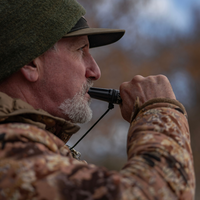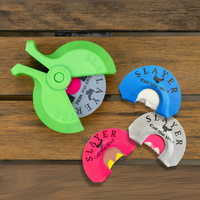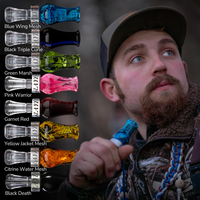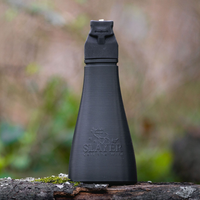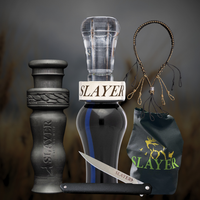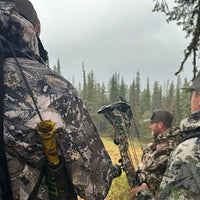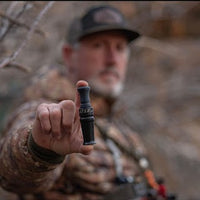How to choose a duck call?
 Before you can choose a duck call, you’ll want to consider where you will use it, how you will use it, and the sounds you’re trying to produce. Each answer can help you determine the tone, range, material, and sharpness you’ll need in your duck call.
The best duck calls help you make the best sounds under your hunting conditions. How and where you intend to use the call — in open water, in timber, over long distances, in close range, etc. — will help you find the right duck call.
For example, the call’s construction determines its volume, ring, and tone. A single-reed duck call produces a different sound than a double-reed duck call. Acrylic, wood, and polycarbonate calls also affect sound. So many hunters find they need different calls for different conditions.
Before you can choose a duck call, you’ll want to consider where you will use it, how you will use it, and the sounds you’re trying to produce. Each answer can help you determine the tone, range, material, and sharpness you’ll need in your duck call.
The best duck calls help you make the best sounds under your hunting conditions. How and where you intend to use the call — in open water, in timber, over long distances, in close range, etc. — will help you find the right duck call.
For example, the call’s construction determines its volume, ring, and tone. A single-reed duck call produces a different sound than a double-reed duck call. Acrylic, wood, and polycarbonate calls also affect sound. So many hunters find they need different calls for different conditions.
What do duck calls do?
Hunters use duck calls to mimic the sound of a duck. A realistic duck call can lure ducks close enough for hunters to take ethical shots. Traditionally, hunters used their voices to imitate ducks. And although hunters began using duck calls in the mid-1800s, calls didn’t become popular until 1935. Since then, duck calls have evolved into the calls you see today. Their design has moved on from the wooden tongue-pincher to modified soundboards and straight-reed and curved-tone boards.
Today, duck calls are usually made of wood and acrylic, and they come with either a single reed or double reed. These materials and their construction allow hunters to change the volume and tone of the call easily.
Traditionally, hunters used their voices to imitate ducks. And although hunters began using duck calls in the mid-1800s, calls didn’t become popular until 1935. Since then, duck calls have evolved into the calls you see today. Their design has moved on from the wooden tongue-pincher to modified soundboards and straight-reed and curved-tone boards.
Today, duck calls are usually made of wood and acrylic, and they come with either a single reed or double reed. These materials and their construction allow hunters to change the volume and tone of the call easily.
How does hunting terrain affect your call?
If you call in open water, like lakes or long rivers, you need a call that carries over long distances. Calls that produce louder, higher pitches will carry the sound farther. The same goes for hunting on public lands where there are other hunters. For that, you’ll need a duck call that can cast a hail call far enough to attract high-flying ducks. Photo by Matt Carey — on Instagram, @of_the_field
Photo by Matt Carey — on Instagram, @of_the_fieldWhat’s the difference between a single-reed call and a double-reed call?
 The reed is the part of the duck call that produces sound. Whether you choose a single-reed or a double-reed duck call depends on your calling ability.
Single-reed calls give hunters more control over the reed, so they require more practice, effort, and airflow to produce an authentic duck imitation. However, single-reed calls have more range, versatility, and adaptability to certain terrains and conditions. And they produce louder and higher notes than double-reed calls.
Double-reed duck calls give hunters less control over the reed, so they take less effort and airflow. As a result, they’re preferable for the basic calls needed for waterfowl hunting. But their range isn’t as broad as a single-reed duck call.
The reed is the part of the duck call that produces sound. Whether you choose a single-reed or a double-reed duck call depends on your calling ability.
Single-reed calls give hunters more control over the reed, so they require more practice, effort, and airflow to produce an authentic duck imitation. However, single-reed calls have more range, versatility, and adaptability to certain terrains and conditions. And they produce louder and higher notes than double-reed calls.
Double-reed duck calls give hunters less control over the reed, so they take less effort and airflow. As a result, they’re preferable for the basic calls needed for waterfowl hunting. But their range isn’t as broad as a single-reed duck call.
What’s the difference between acrylic, wood, and polycarbonate duck calls?
Different barrel materials produce different echoes, which influence the duck call’s sound. The most common materials used to make duck calls are acrylic, wood, and polycarbonate. Acrylic is a dense material, so these duck calls are the most durable. They produce a sharp tone at a higher volume than wood and polycarbonate calls, so they’re a good choice for long-range duck calling. In addition, acrylic duck calls are easier to maintain and produce more consistent sounds than wood calls. .
.  Wood duck calls produce a softer, smoother, and more natural sound. Wood retains sound vibrations, so it delivers a slightly muted tone. Wood duck calls produce a more natural duck sound than acrylic and polycarbonate calls. They aren’t as durable or versatile as acrylic calls, but they are an excellent choice for close-range hunting. Because of their porous nature, these calls require more care.
Wood duck calls produce a softer, smoother, and more natural sound. Wood retains sound vibrations, so it delivers a slightly muted tone. Wood duck calls produce a more natural duck sound than acrylic and polycarbonate calls. They aren’t as durable or versatile as acrylic calls, but they are an excellent choice for close-range hunting. Because of their porous nature, these calls require more care.
 Polycarbonate duck calls fall between wood and acrylic calls in terms of sound. They produce a sharp tone, but it’s not as sharp as an acrylic call. They’re more durable than wood, but they’re not as strong as acrylic. They don’t last as long as acrylic calls, but they’re less expensive.
Polycarbonate duck calls fall between wood and acrylic calls in terms of sound. They produce a sharp tone, but it’s not as sharp as an acrylic call. They’re more durable than wood, but they’re not as strong as acrylic. They don’t last as long as acrylic calls, but they’re less expensive.
 Let us help you find the right duck call for your next hunt. Shop duck calls
Featured photo for this article (top, main image) is courtesy of Matt Carey.
Let us help you find the right duck call for your next hunt. Shop duck calls
Featured photo for this article (top, main image) is courtesy of Matt Carey.